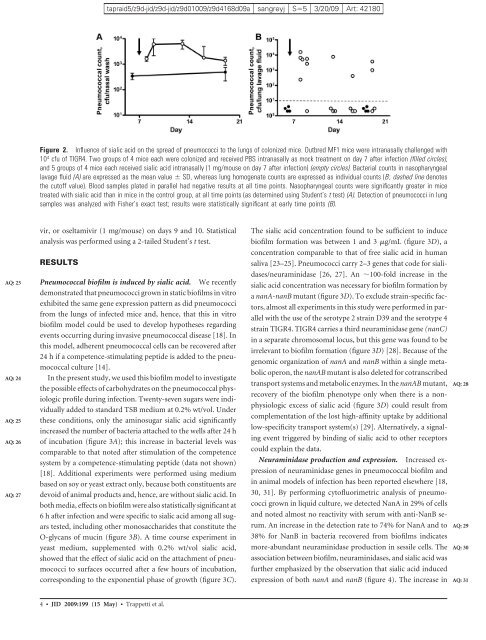5 The role of quorum-sensing in the virulence of Pseudomonas ...
5 The role of quorum-sensing in the virulence of Pseudomonas ...
5 The role of quorum-sensing in the virulence of Pseudomonas ...
You also want an ePaper? Increase the reach of your titles
YUMPU automatically turns print PDFs into web optimized ePapers that Google loves.
AQ: 23<br />
AQ: 24<br />
AQ: 25<br />
AQ: 26<br />
AQ: 27<br />
Figure 2. Influence <strong>of</strong> sialic acid on <strong>the</strong> spread <strong>of</strong> pneumococci to <strong>the</strong> lungs <strong>of</strong> colonized mice. Outbred MF1 mice were <strong>in</strong>tranasally challenged with<br />
10 4 cfu <strong>of</strong> TIGR4. Two groups <strong>of</strong> 4 mice each were colonized and received PBS <strong>in</strong>tranasally as mock treatment on day 7 after <strong>in</strong>fection (filled circles),<br />
and 5 groups <strong>of</strong> 4 mice each received sialic acid <strong>in</strong>tranasally (1 mg/mouse on day 7 after <strong>in</strong>fection) (empty circles). Bacterial counts <strong>in</strong> nasopharyngeal<br />
lavage fluid (A) are expressed as <strong>the</strong> mean value � SD, whereas lung homogenate counts are expressed as <strong>in</strong>dividual counts (B ; dashed l<strong>in</strong>e denotes<br />
<strong>the</strong> cut<strong>of</strong>f value). Blood samples plated <strong>in</strong> parallel had negative results at all time po<strong>in</strong>ts. Nasopharyngeal counts were significantly greater <strong>in</strong> mice<br />
treated with sialic acid than <strong>in</strong> mice <strong>in</strong> <strong>the</strong> control group, at all time po<strong>in</strong>ts (as determ<strong>in</strong>ed us<strong>in</strong>g Student’s t test) (A). Detection <strong>of</strong> pneumococci <strong>in</strong> lung<br />
samples was analyzed with Fisher’s exact test; results were statistically significant at early time po<strong>in</strong>ts (B).<br />
vir, or oseltamivir (1 mg/mouse) on days 9 and 10. Statistical<br />
analysis was performed us<strong>in</strong>g a 2-tailed Student’s t test.<br />
RESULTS<br />
Pneumococcal bi<strong>of</strong>ilm is <strong>in</strong>duced by sialic acid. We recently<br />
demonstrated that pneumococci grown <strong>in</strong> static bi<strong>of</strong>ilms <strong>in</strong> vitro<br />
exhibited <strong>the</strong> same gene expression pattern as did pneumococci<br />
from <strong>the</strong> lungs <strong>of</strong> <strong>in</strong>fected mice and, hence, that this <strong>in</strong> vitro<br />
bi<strong>of</strong>ilm model could be used to develop hypo<strong>the</strong>ses regard<strong>in</strong>g<br />
events occurr<strong>in</strong>g dur<strong>in</strong>g <strong>in</strong>vasive pneumococcal disease [18]. In<br />
this model, adherent pneumococcal cells can be recovered after<br />
24 h if a competence-stimulat<strong>in</strong>g peptide is added to <strong>the</strong> pneumococcal<br />
culture [14].<br />
In <strong>the</strong> present study, we used this bi<strong>of</strong>ilm model to <strong>in</strong>vestigate<br />
<strong>the</strong> possible effects <strong>of</strong> carbohydrates on <strong>the</strong> pneumococcal physiologic<br />
pr<strong>of</strong>ile dur<strong>in</strong>g <strong>in</strong>fection. Twenty-seven sugars were <strong>in</strong>dividually<br />
added to standard TSB medium at 0.2% wt/vol. Under<br />
<strong>the</strong>se conditions, only <strong>the</strong> am<strong>in</strong>osugar sialic acid significantly<br />
<strong>in</strong>creased <strong>the</strong> number <strong>of</strong> bacteria attached to <strong>the</strong> wells after 24 h<br />
<strong>of</strong> <strong>in</strong>cubation (figure 3A); this <strong>in</strong>crease <strong>in</strong> bacterial levels was<br />
comparable to that noted after stimulation <strong>of</strong> <strong>the</strong> competence<br />
system by a competence-stimulat<strong>in</strong>g peptide (data not shown)<br />
[18]. Additional experiments were performed us<strong>in</strong>g medium<br />
based on soy or yeast extract only, because both constituents are<br />
devoid <strong>of</strong> animal products and, hence, are without sialic acid. In<br />
both media, effects on bi<strong>of</strong>ilm were also statistically significant at<br />
6 h after <strong>in</strong>fection and were specific to sialic acid among all sugars<br />
tested, <strong>in</strong>clud<strong>in</strong>g o<strong>the</strong>r monosaccharides that constitute <strong>the</strong><br />
O-glycans <strong>of</strong> muc<strong>in</strong> (figure 3B). A time course experiment <strong>in</strong><br />
yeast medium, supplemented with 0.2% wt/vol sialic acid,<br />
showed that <strong>the</strong> effect <strong>of</strong> sialic acid on <strong>the</strong> attachment <strong>of</strong> pneumococci<br />
to surfaces occurred after a few hours <strong>of</strong> <strong>in</strong>cubation,<br />
correspond<strong>in</strong>g to <strong>the</strong> exponential phase <strong>of</strong> growth (figure 3C).<br />
4 ● JID 2009:199 (15 May) ● Trappetti et al.<br />
tapraid5/z9d-jid/z9d-jid/z9d01009/z9d4168d09a sangreyj S�5 3/20/09 Art: 42180<br />
<strong>The</strong> sialic acid concentration found to be sufficient to <strong>in</strong>duce<br />
bi<strong>of</strong>ilm formation was between 1 and 3 �g/mL (figure 3D), a<br />
concentration comparable to that <strong>of</strong> free sialic acid <strong>in</strong> human<br />
saliva [23–25]. Pneumococci carry 2–3 genes that code for sialidases/neuram<strong>in</strong>idase<br />
[26, 27]. An �100-fold <strong>in</strong>crease <strong>in</strong> <strong>the</strong><br />
sialic acid concentration was necessary for bi<strong>of</strong>ilm formation by<br />
a nanA-nanB mutant (figure 3D). To exclude stra<strong>in</strong>-specific factors,<br />
almost all experiments <strong>in</strong> this study were performed <strong>in</strong> parallel<br />
with <strong>the</strong> use <strong>of</strong> <strong>the</strong> serotype 2 stra<strong>in</strong> D39 and <strong>the</strong> serotype 4<br />
stra<strong>in</strong> TIGR4. TIGR4 carries a third neuram<strong>in</strong>idase gene (nanC)<br />
<strong>in</strong> a separate chromosomal locus, but this gene was found to be<br />
irrelevant to bi<strong>of</strong>ilm formation (figure 3D) [28]. Because <strong>of</strong> <strong>the</strong><br />
genomic organization <strong>of</strong> nanA and nanB with<strong>in</strong> a s<strong>in</strong>gle metabolic<br />
operon, <strong>the</strong> nanAB mutant is also deleted for cotranscribed<br />
transport systems and metabolic enzymes. In <strong>the</strong> nanAB mutant,<br />
recovery <strong>of</strong> <strong>the</strong> bi<strong>of</strong>ilm phenotype only when <strong>the</strong>re is a nonphysiologic<br />
excess <strong>of</strong> sialic acid (figure 3D) could result from<br />
complementation <strong>of</strong> <strong>the</strong> lost high-aff<strong>in</strong>ity uptake by additional<br />
low-specificity transport system(s) [29]. Alternatively, a signal<strong>in</strong>g<br />
event triggered by b<strong>in</strong>d<strong>in</strong>g <strong>of</strong> sialic acid to o<strong>the</strong>r receptors<br />
could expla<strong>in</strong> <strong>the</strong> data.<br />
Neuram<strong>in</strong>idase production and expression. Increased expression<br />
<strong>of</strong> neuram<strong>in</strong>idase genes <strong>in</strong> pneumococcal bi<strong>of</strong>ilm and<br />
<strong>in</strong> animal models <strong>of</strong> <strong>in</strong>fection has been reported elsewhere [18,<br />
30, 31]. By perform<strong>in</strong>g cyt<strong>of</strong>luorimetric analysis <strong>of</strong> pneumococci<br />
grown <strong>in</strong> liquid culture, we detected NanA <strong>in</strong> 29% <strong>of</strong> cells<br />
and noted almost no reactivity with serum with anti-NanB serum.<br />
An <strong>in</strong>crease <strong>in</strong> <strong>the</strong> detection rate to 74% for NanA and to<br />
38% for NanB <strong>in</strong> bacteria recovered from bi<strong>of</strong>ilms <strong>in</strong>dicates<br />
more-abundant neuram<strong>in</strong>idase production <strong>in</strong> sessile cells. <strong>The</strong><br />
association between bi<strong>of</strong>ilm, neuram<strong>in</strong>idases, and sialic acid was<br />
fur<strong>the</strong>r emphasized by <strong>the</strong> observation that sialic acid <strong>in</strong>duced<br />
expression <strong>of</strong> both nanA and nanB (figure 4). <strong>The</strong> <strong>in</strong>crease <strong>in</strong><br />
AQ: 28<br />
AQ: 29<br />
AQ: 30<br />
AQ: 31














